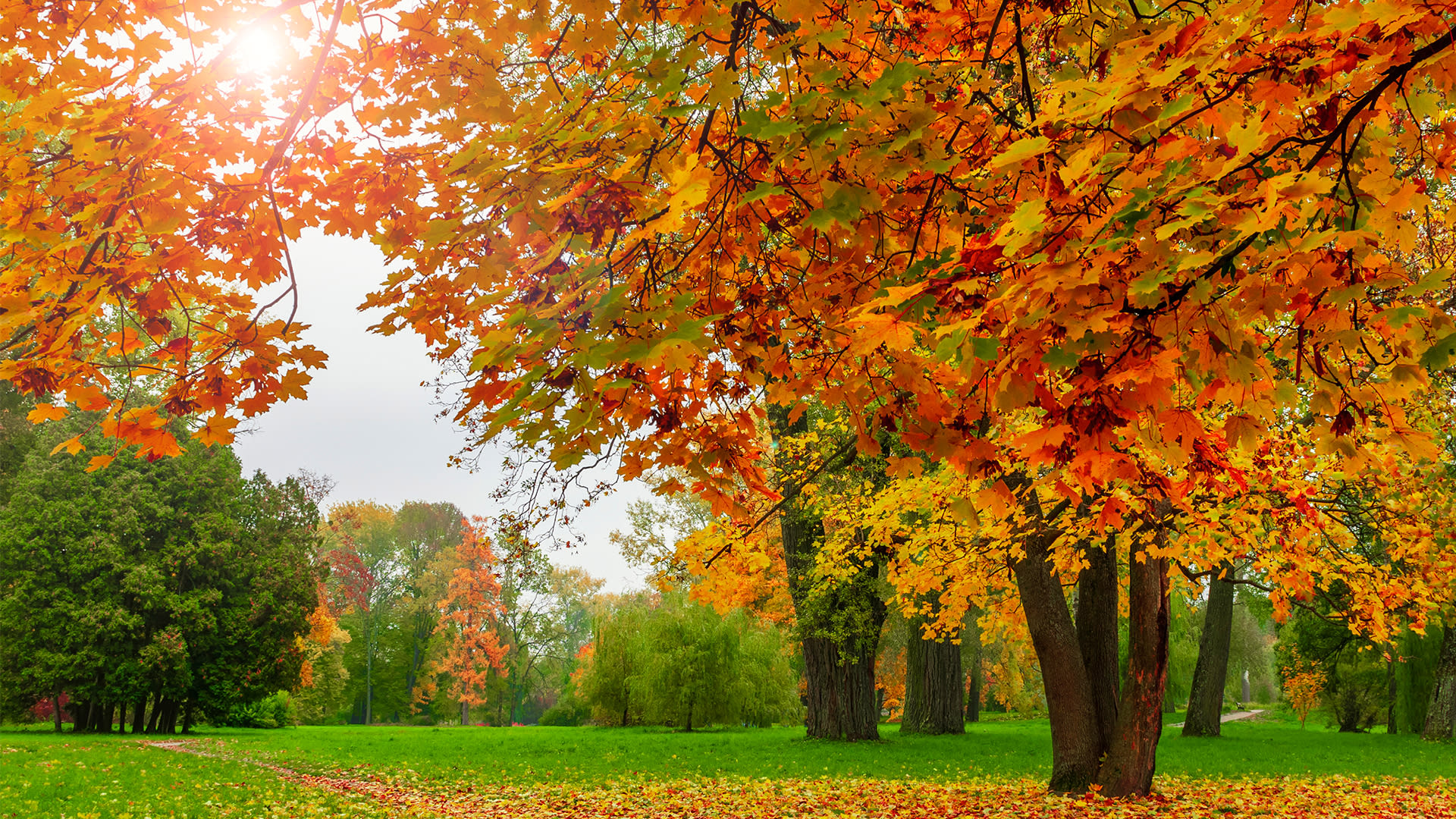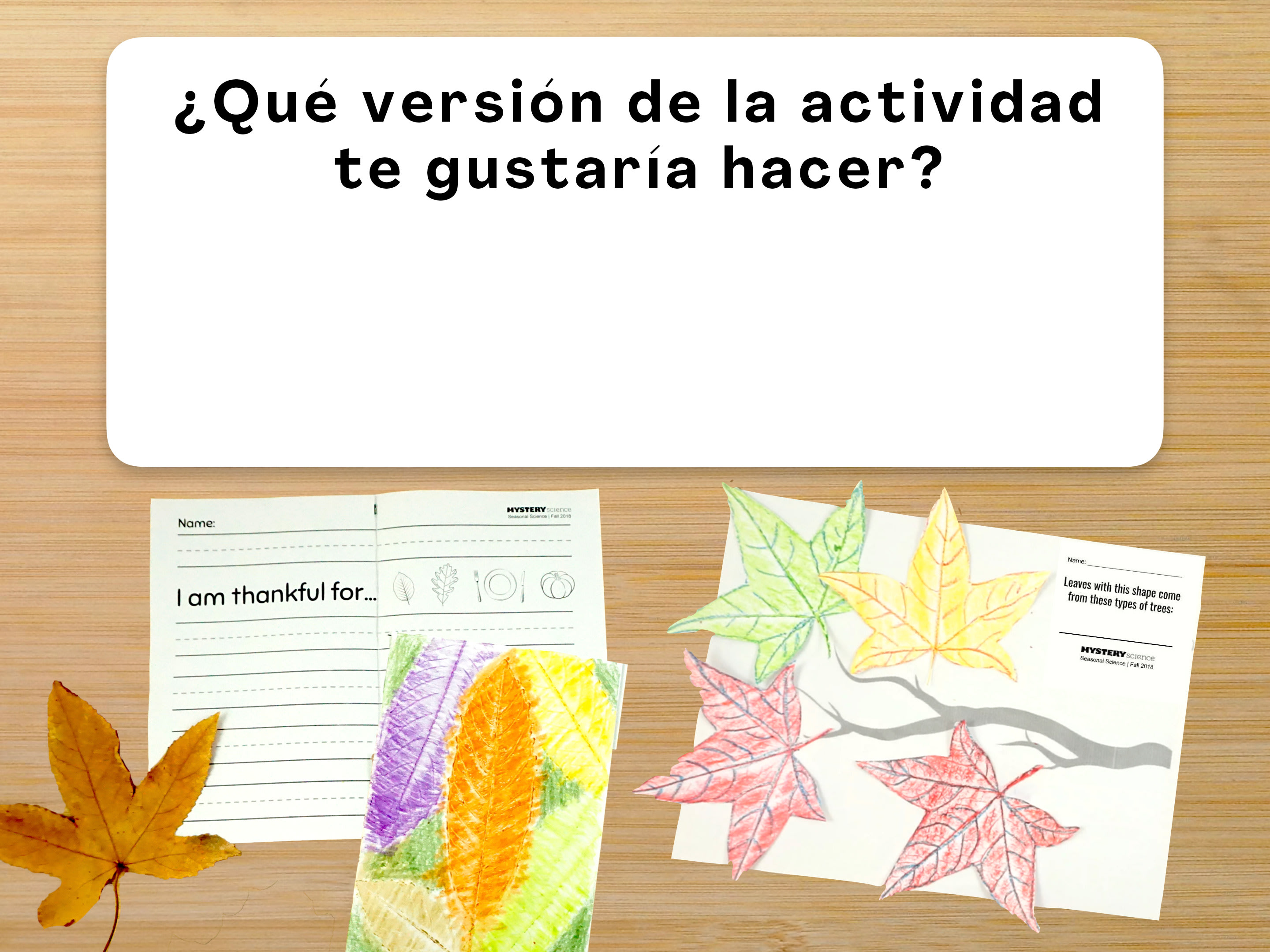Scroll for prep

Please wait…
This video is having trouble loading. You may have lost your Internet connection.
Step 1: Click to Reload this page
Step 2: Click to
Try our other video player
Step 3: contact support if trouble persists.
Or,
dismiss this message.
CONVERSEMOS:
¿Por qué crees que las hojas cambian de color en otoño?

Please wait…
This video is having trouble loading. You may have lost your Internet connection.
Step 1: Click to Reload this page
Step 2: Click to
Try our other video player
Step 3: contact support if trouble persists.
Or,
dismiss this message.

Please wait…
This video is having trouble loading. You may have lost your Internet connection.
Step 1: Click to Reload this page
Step 2: Click to
Try our other video player
Step 3: contact support if trouble persists.
Or,
dismiss this message.

Please wait…
This video is having trouble loading. You may have lost your Internet connection.
Step 1: Click to Reload this page
Step 2: Click to
Try our other video player
Step 3: contact support if trouble persists.
Or,
dismiss this message.
Paso
01/09
01/09
Encuentra un compañero o una compañera con quién trabajar.
Si estás trabajando solo o sola, también está bien.
Si estás trabajando solo o sola, también está bien.

Please wait…
This video is having trouble loading. You may have lost your Internet connection.
Step 1: Click to Reload this page
Step 2: Click to
Try our other video player
Step 3: contact support if trouble persists.
Or,
dismiss this message.
Paso
02/09
02/09
Obtén estos materiales.

Please wait…
This video is having trouble loading. You may have lost your Internet connection.
Step 1: Click to Reload this page
Step 2: Click to
Try our other video player
Step 3: contact support if trouble persists.
Or,
dismiss this message.
Paso
03/09
03/09
Alíneala la regla con las líneas gruesas en la tarjeta. Dobla la tarjeta a
la mitad. Remarca el doblez con tu uña para hacer un buen pliegue.
la mitad. Remarca el doblez con tu uña para hacer un buen pliegue.

Please wait…
This video is having trouble loading. You may have lost your Internet connection.
Step 1: Click to Reload this page
Step 2: Click to
Try our other video player
Step 3: contact support if trouble persists.
Or,
dismiss this message.
Paso
04/09
04/09
Abre tu tarjeta y coloca tu hoja adentro, así. Luego pon otra hoja de
papel debajo de tu tarjeta.
papel debajo de tu tarjeta.

Please wait…
This video is having trouble loading. You may have lost your Internet connection.
Step 1: Click to Reload this page
Step 2: Click to
Try our other video player
Step 3: contact support if trouble persists.
Or,
dismiss this message.
Paso
05/09
05/09
Colorea sobre el área donde está la hoja en tu tarjeta. Asegúrate de
que tu hoja no se mueva.
que tu hoja no se mueva.

Please wait…
This video is having trouble loading. You may have lost your Internet connection.
Step 1: Click to Reload this page
Step 2: Click to
Try our other video player
Step 3: contact support if trouble persists.
Or,
dismiss this message.
Paso
06/09
06/09
Mira de cerca el dibujo de tu hoja. Compárala con el de tu
compañero/a. Conversemos.
compañero/a. Conversemos.

Please wait…
This video is having trouble loading. You may have lost your Internet connection.
Step 1: Click to Reload this page
Step 2: Click to
Try our other video player
Step 3: contact support if trouble persists.
Or,
dismiss this message.
Paso
07/09
07/09
Veamos la hoja de trabajo sobre las Formas de las Hojas.
Encierra en un círculo todas las cosas que notas sobre tu hoja.
Encierra en un círculo todas las cosas que notas sobre tu hoja.

Please wait…
This video is having trouble loading. You may have lost your Internet connection.
Step 1: Click to Reload this page
Step 2: Click to
Try our other video player
Step 3: contact support if trouble persists.
Or,
dismiss this message.
Paso
08/09
08/09
Mueve la hoja a otro lugar dentro de la tarjeta y escoge otro color
de crayón. Colorea sobre la hoja otra vez.
de crayón. Colorea sobre la hoja otra vez.

Please wait…
This video is having trouble loading. You may have lost your Internet connection.
Step 1: Click to Reload this page
Step 2: Click to
Try our other video player
Step 3: contact support if trouble persists.
Or,
dismiss this message.
Paso
09/09
09/09
Abre tu tarjeta y escribe una cosa por la que estés agradecido/a
este año. Puedes llevártela a tu casa y dársela a alguien especial.
este año. Puedes llevártela a tu casa y dársela a alguien especial.
Ve otras lecciones de otoño para tu edad:

Please wait…
This video is having trouble loading. You may have lost your Internet connection.
Step 1: Click to Reload this page
Step 2: Click to
Try our other video player
Step 3: contact support if trouble persists.
Or,
dismiss this message.

Please wait…
This video is having trouble loading. You may have lost your Internet connection.
Step 1: Click to Reload this page
Step 2: Click to
Try our other video player
Step 3: contact support if trouble persists.
Or,
dismiss this message.
Paso
01/11
01/11
Encuentra un compañero o una compañera con quien trabajar.
Si estás trabajando solo o sola, también está bien.
Si estás trabajando solo o sola, también está bien.

Please wait…
This video is having trouble loading. You may have lost your Internet connection.
Step 1: Click to Reload this page
Step 2: Click to
Try our other video player
Step 3: contact support if trouble persists.
Or,
dismiss this message.
Paso
02/11
02/11
Obtén estos materiales. Recibirás otros más adelante.

Please wait…
This video is having trouble loading. You may have lost your Internet connection.
Step 1: Click to Reload this page
Step 2: Click to
Try our other video player
Step 3: contact support if trouble persists.
Or,
dismiss this message.
Paso
03/11
03/11
Pon tu hoja sobre tu escritorio y cúbrela con una hoja de papel.

Please wait…
This video is having trouble loading. You may have lost your Internet connection.
Step 1: Click to Reload this page
Step 2: Click to
Try our other video player
Step 3: contact support if trouble persists.
Or,
dismiss this message.
Paso
04/11
04/11
Con un crayón vas a colorear sobre el área que está sobre la hoja
del árbol. Detén la hoja de papel para que tu hoja no se mueva.
del árbol. Detén la hoja de papel para que tu hoja no se mueva.

Please wait…
This video is having trouble loading. You may have lost your Internet connection.
Step 1: Click to Reload this page
Step 2: Click to
Try our other video player
Step 3: contact support if trouble persists.
Or,
dismiss this message.
Paso
05/11
05/11
Vas a calcar tres veces más la misma hoja. Mueve tu hoja a otro
lugar debajo del papel, para que las hojas no queden una arriba
de otra.
lugar debajo del papel, para que las hojas no queden una arriba
de otra.

Please wait…
This video is having trouble loading. You may have lost your Internet connection.
Step 1: Click to Reload this page
Step 2: Click to
Try our other video player
Step 3: contact support if trouble persists.
Or,
dismiss this message.
Paso
06/11
06/11
Mira de cerca las hojas. Compáralas con las de tu compañero/a.
Conversemos.
Conversemos.

Please wait…
This video is having trouble loading. You may have lost your Internet connection.
Step 1: Click to Reload this page
Step 2: Click to
Try our other video player
Step 3: contact support if trouble persists.
Or,
dismiss this message.
Paso
07/11
07/11
Escoge un crayón de un color oscuro y remarques los nervios.
También puedes trazar el contorno de la hoja.
También puedes trazar el contorno de la hoja.

Please wait…
This video is having trouble loading. You may have lost your Internet connection.
Step 1: Click to Reload this page
Step 2: Click to
Try our other video player
Step 3: contact support if trouble persists.
Or,
dismiss this message.
Paso
08/11
08/11
Obtén el resto de tus materiales.

Please wait…
This video is having trouble loading. You may have lost your Internet connection.
Step 1: Click to Reload this page
Step 2: Click to
Try our other video player
Step 3: contact support if trouble persists.
Or,
dismiss this message.
Paso
09/11
09/11
Recorta cada una de tus hojas. Pégalas en tu rama del Árbol
Comunitario. Intenta no cubrir las palabras en la página.
Comunitario. Intenta no cubrir las palabras en la página.

Please wait…
This video is having trouble loading. You may have lost your Internet connection.
Step 1: Click to Reload this page
Step 2: Click to
Try our other video player
Step 3: contact support if trouble persists.
Or,
dismiss this message.
Paso
10/11
10/11
Escribe el nombre del árbol en tu hoja. Si no encuentras una hoja
igual a la tuya, no te preocupes. A lo mejor tienes una hoja especial.
igual a la tuya, no te preocupes. A lo mejor tienes una hoja especial.

Please wait…
This video is having trouble loading. You may have lost your Internet connection.
Step 1: Click to Reload this page
Step 2: Click to
Try our other video player
Step 3: contact support if trouble persists.
Or,
dismiss this message.
Paso
11/11
11/11
Pega tu rama en el tronco para formar un Árbol Comunitario.
También puedes llevarte a casa tu guía de identificación de hojas
y usarla para descubrir qué árboles crecen en tu vecindario.
También puedes llevarte a casa tu guía de identificación de hojas
y usarla para descubrir qué árboles crecen en tu vecindario.
🎉
That’s it for this lesson! How did it go?
Sign up now for more great lessons!




